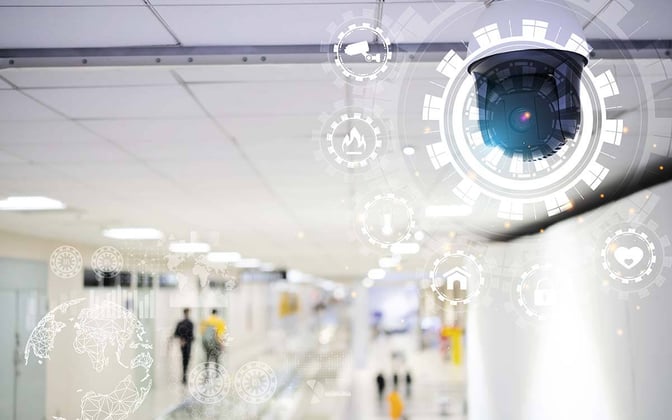Many believe it is impossible to be everywhere all at once.
The truth is – with a proper video security system, you can!
When an organization operates across multiple locations, a basic video security system won't cut it. The needs and requirements for a multi-site video security system are more complex than a system operating for one location. The ultimate goal is to establish a seamless security system that spans multiple sites and allows for remote access control.
Let's dive into some crucial mistakes to steer clear of while constructing a video surveillance system:
Video Surveillance System Hazards
There are three essential components of any video security system: the cameras themselves, access control and intrusion alarms and monitoring.
These three components need to work together in any well-designed commercial surveillance system, and a multi-site video security system has special considerations that can make or break how useful it will be in keeping your organization safe.
1. Mismatched video security systems across multiple sites
A disconnected, outdated network of cameras, all on different operating systems does you no good. Consider this client example. AH Hermel is a company that provides vending services and food distribution to plants and factories in Minnesota and Iowa, and they’re an organization that has grown over the years, acquiring businesses in new towns as they expanded.
After acquiring several disjointed camera systems over the years, they asked Loffler for help installing a new, centralized system to secure their facilities.
Why? Because in this case (and many others), these video surveillance systems were likely installed at various times, creating a wide range of ages for the entire system as a whole. This is not ideal. Broken cameras cause unnecessary headaches, especially when multiple service providers are involved, who can be unresponsive or delayed. This often leaves management with several different applications to review footage, and some of that scattered software will inevitably go out of support before the rest of your system.
This is why AH Hermel needed a change, and Loffler was able to centralize their video surveillance monitoring system to gain full remote access control. Learn more in our AH Hermel Physical Security Case Study below:
2. Importance of remote access in video security systems
Going off of the first item on the list – a security system that spans multiple locations needs to have the ability for you to remotely access the camera monitoring system from anywhere. This allows for the utmost flexibility in any workplace.
Think about this. A CEO, sitting at headquarters, shouldn’t have to call a manager in a separate branch location to have them check the video recordings if something seems out of place. This makes reviewing camera footage a hassle and time-consuming. That CEO, or whoever is monitoring the video surveillance system, should also be able to check the system on the go, with 24/7 remote mobile access.
Remote video monitoring is one of the primary benefits of installing a new video security system.
3. The crucial role of access control in video security systems
It’s common to seek out a video security system and expect that all you’ll need is a camera (or several) to make it effective. But a camera on its own won’t adequately protect an organization.Access control is the element of a video security system that will stop an individual from accessing a location where they’re not allowed. This can be done with a pin number and a keypad, card access or biometrics like facial recognition.
Access control provides much more security than simply having a lock on a door. It prevents a person from accessing doors outside of normal business hours that they would otherwise be able to open. It can keep the wrong people out of sensitive areas like networking closets or confidential file storage while letting people with the correct permissions in, so they can continue to do their jobs.
4. Securing your premises: the importance of intrusion alarms and notifications in video security systems
Like access control, intrusion alarms and notifications are elements of a video security system that are often overlooked or assumed to come with the cameras. However, this is a separate element that should be woven into the overall video security system.
Intrusion alarms sound when a person accesses an area where they're not permitted. This could either mean an employee or customer entering a space where their safety is a concern, or an intruder breaking in and harming a business. Alarms can even be set based on environmental factors, for example, scanning for temperature spikes in rooms with sensitive equipment.
When an alarm is triggered, the appropriate party – whether a member of your team, a security firm, or the local authorities – can be notified and take action.
Integrating intrusion alarms and notifications into your video security system will enhance your security posture and make the system whole.
5. Insufficient bandwidth: a common issue with video security systems
Nothing is worse than slow internet, but it is a common issue that directly affects video surveillance. This issue has less to do with the system itself and more with what resources you have available to support it.
Like many systems in a modern office environment, many features of a video surveillance system are dependent on the internet. The camera system set-up at each site needs to have an internet connection and its own IP address, and the internet for each needs to be high speed. Without a high-speed internet connection, your cameras can still work for the site where they’re located, but you won’t be able to reliably access the camera feed remotely, and notifications may be delayed or fully dropped.
The last thing you want is to invest in a remote video surveillance system that is at times unusable due to slow internet speeds. That is time and money wasted.
6. Not hiring professionals to install and implement your video security system
Once a video security system has been selected to meet the needs of multiple locations, the next step is to install and begin using it. While mounting cameras on the walls may seem like an easy DIY project, multi camera security systems tend to be complex, so professional installation is highly recommended.
The video security system needs to be fully integrated into each location. This means not only having them mounted but setting up recorders with any necessary equipment (a workstation monitor at minimum is common) and having the proper cabling in place to connect cameras to the recorder.
Working in tandem with security experts will make planning, implementation and future updates/maintenance a pleasant experience. Your physical security provider should work with you every step of the way because nobody understands your organization’s needs like you. Your security provider will help you find solutions to meet those needs.
The video security experts at Loffler have years of experience designing, installing and maintaining video security systems for organizations large and small across all industries. Contact us today to begin planning your system today! 
Read Next: Three Reasons You Should Consider a Cloud-Based Security System

Anthony is the Practice Manager of Physical Security at Loffler Companies. He began his technology career in 1993 installing POS and audio/video equipment in retail and commercial environments. With more than 25 years of technology background, Anthony has built and managed several enterprise-level surveillance systems consisting of more than 56,000 cameras in 830 locations in the United States and Canada. He was instrumental in the design and implementation of major surveillance systems for Life Time Fitness – supporting 9000+ cameras running Milestone Systems and JCPenney – supporting 42,000+ cameras running ExacqVision. In addition, he brings a strong background in operational leadership and knowledge in multi-site real estate management and construction. Anthony has had certifications with AXIS, Milestone, Genetec, ASIS, BICSI, NICET, Microsoft and Cisco along with various Access Control, Audio Visual and Project Management certifications. In his free time, he enjoys the outdoors with his son and daughter.




